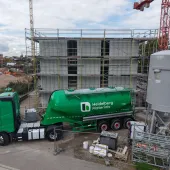Tackling highwall stabilisation in former quarries
UK-based foundation specialist Roger Bullivant Limited (RBL) is using innovative engineering techniques to solve geotechnical challenges at former quarry sites, where unstable highwalls and backfilled ground make construction difficult.
Highwalls, often poorly marked, introduce uncertainties that affect piling performance. According to RBL, using advanced site investigations and customised piling designs helps address these challenges and ensures stable foundations.
A recent residential development at Watermills Road, Chesterton faced uncertainty regarding highwall locations. Initial ground investigations revealed deep layers of made ground, stiff clay, and weak mudstone bedrock, leading to significant design changes.
Instead of traditional precast piles, RBL opted for tubular steel piles to address variability in the ground. The company divided the site into phases for targeted analysis, using additional probing and load testing to adjust designs for ground variation.
“Our open-ended steel piles were filled with concrete to prevent contamination and reinforced to resist ground heave,” said RBL spokesperson.
At a housing development at Leighton Buzzard, where the position of the highwall was clearly marked, Continuous Flight Auger (CFA) piles were used in highwall areas, while precast concrete piles were installed elsewhere. Discrepancies in pile lengths prompted further investigation, revealing variations in the ground’s fill material.
RBL adapted its piling strategy based on probe data, switching between precast and CFA piles to avoid any geological anomalies. “Our flexible approach helped us tackle the highwall’s uncertainties and ensure the foundation's integrity,” said the company.







